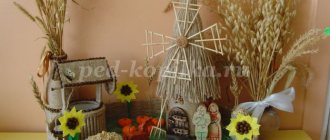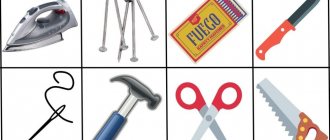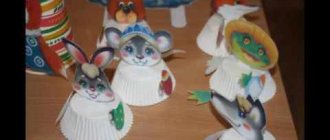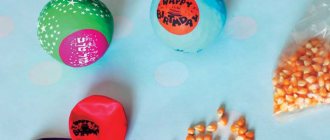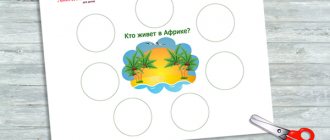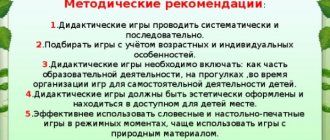Preschool age is a period of intense sensory development. The child learns about the world through the senses and masters ways of manipulating objects. Sensory is the basis for the emergence of cognitive mental processes and speech. To develop a child’s sensory system, no special conditions or activities are required; you can create sensory games for children 2-3 years old with your own hands.
A game for sensory development.
The concept of sensory
“The child’s mind is at the tips of his fingers” - the words of the Soviet teacher V. Sukhomlinsky accurately reflect the tasks of raising a preschooler. In early childhood (from 1 to 3 years), development occurs through objective activity, in which imaginative thinking is formed. It is important for children to taste an object, feel its structure, and touch the surface. By interacting with surrounding objects, the child learns to perceive and analyze information. The senses and corresponding analyzers help him in this:
- visual;
- auditory;
- tactile;
- olfactory;
- taste.
Through these systems, ideas about the surrounding reality are formed, which are enshrined in sensory standards - generally accepted properties of objects. Such standards are shapes, colors, size, taste, sound level, temperature.
The sensory system of a preschooler includes two interconnected aspects:
- Mastering ideas about the properties and relationships of objects. The child is looking for new ways to interact with previously unknown objects.
- Mastering new perceptual actions that allow you to more fully perceive the world around you. The child can perform operations not with objects, but with symbols, and becomes able to solve simple problems in his mind, without resorting to trial and error.
Sensory development allows:
Sensory skills improve attention.
- enrich your vocabulary;
- form the correct structure of speech;
- improve cognitive mental processes: memory, attention, thinking, perception;
- develop imagination;
- obtain complete information about the surrounding reality;
- improve communication skills.
A child who has a developed system of perception and processing of information is able to navigate perfectly in the conditions of the modern world.
Sensory education in children 2-3 years old
In order to purposefully influence the sensory skills of preschoolers, it is necessary to know the main stages of sensory development, be able to diagnose its level and correlate it with age-related characteristics. Among them are the following:
- Getting to know an object through perception through the senses. The child puts it into his mouth, tastes it, feels it, smells it, evaluates its shape and size.
- Formation of skills to correlate the spatial arrangement of objects, connect objects and their parts. The child evaluates the sizes of objects and their relationships. To do this, you need to teach children to put one object into another (games with a pyramid work well), string beads on a cord, and push small objects into various holes. The child becomes familiar with composite objects, with the concept of the whole and parts. Games with large puzzles, cut-out pictures, and construction sets of 2-4 elements will help him with this. At the first stage, the child is able to assemble a matryoshka doll from 2 elements.
- Mastering ways to practically distinguish the properties of objects. A preschooler learns to compare two similar objects through practical actions: putting one on top of the other, the relationship between shape and color. At the second stage, the child is able to assemble a matryoshka doll from 3 elements.
- Formation of manipulative actions with an object based on repeated repetition. After practical manipulations with an object, the child is able to visually correlate the size and shape of objects using only mental operations. He can group objects according to one characteristic, select 3 objects according to a given pattern, and is able to sort objects from smallest to largest. At this stage, the preschooler assembles a five-seater nesting doll.
- Complicating the conditions for performing actions that require correlation according to one of the characteristics. The child groups objects according to several characteristics, is able to correlate 6 or more colors with each other, and visually selects a pair of objects according to given characteristics.
- Using learned actions in solving practical and cognitive problems. The child is able to reproduce acquired knowledge and skills, differentiate the properties of objects, and apply subject standards in solving assigned problems. At this stage, a 3-year-old child can correctly assemble a pyramid of 8 rings in descending order of their size.
Sensory education is a targeted didactic impact on the sensory systems of preschool children, which becomes more complex with each new stage of sensory development. Creating conditions for the comprehensive development of the senses is the task of parents and teachers of preschool educational and developmental institutions.
Progress of the game:
A hare appears with a basket and cries.
Educator : Why are you crying, little bunny?
Bunny: I bought gifts for my bunnies - shorts and skirts. While I was walking through the forest, I touched a bush and they tore. (Shows cardboard )
.
Educator : Don’t cry, bunny, we will help you. Children, let's pick up patches and patch up the holes. What do the holes in skirts and shorts look like?
Children: triangle, square and circle.
Educator : Correct.
The hare puts her shorts and skirts on the “stumps”
(tables on which patches are laid out in advance. Children approach the tables and complete the task.
The teacher asks each child what color of patch he put on and what geometric figure it resembles.
Hare: Thank you very much, children!
"Big and small balls"
.
Purpose: To teach to distinguish color and size (large - small)
; develop a sense of rhythm; pronounce words rhythmically.
Game task. Pick up balls for dolls.
Game rule. Choose the right balls by color and size.
Progress of the game. The teacher gives balls of different colors to look at (blue, green, red, yellow)
and different sizes
(large and small)
. Shows how they jump rhythmically and says: Jump and jump,
Everybody jump and jump
Sleep our ball
Not used to it.
The teacher brings out two dolls - a large and a small one - and says: “The big doll Olya is looking for a ball for herself. Little doll Ira also wants to play with the ball.” Invites the children to pick up balls for the dolls. Children select balls of the required size (for a large doll - a large ball, for a small doll - a small ball)
The doll Olya is capricious: she needs a yellow ball, like her skirt. The doll Ira is also angry: she needs a red ball, like her bow.
The teacher invites the children to calm the dolls: pick them the right balls.
"Hide the mouse"
Goals:
Continue to introduce children to the six primary colors and teach them to distinguish them. Develop reaction speed, attention, thinking. Strengthen knowledge about animals.
Material:
Demonstration: pieces of paper in six colors (20 - 15, in the middle there is a white square (8-8), on which a mouse is drawn (a mouse house, squares of the same six colors - doors (10x10), a large cardboard toy - a cat , a soft mouse.
Handout: this material is smaller in size - 10x8 colored sheets, 5x5 white squares on them, colored squares.
Card index of didactic games on sensory education for young children 2-3 years old
Didactic material for sensory education - systematized sets of objects or pictures that give children the opportunity to practice identifying certain characteristics of objects, comparing some objects with others, grouping objects, and solving problems on their spatial arrangement. As cognitive abilities develop, the material becomes more complex.
Learning takes place in a playful way so that preschoolers remain highly motivated to study.
Requirements for educational games:
- safety;
- visibility;
- naturalness of materials;
- brightness and naturalness of colors;
- availability;
- age appropriate.
Formative environment and game methods
According to R.A. Kurashova, we can highlight a subject-based developmental environment, which is one of the conditions for the development of sensory standards in preschoolers.
Today, as the education system improves, as the principles of humanization of the educational process are introduced, great importance is attached to the creation of a formative environment.
The environment, which includes the child's environment, consists of the family, immediate environment and social environment. The environment can both enhance and inhibit a child’s development. But she cannot but influence his development at all.
The developing subject environment is a complex of objects of the material world with which the child interacts. It allows you to model the content of the child’s physical and spiritual appearance.
In order for didactic games to produce results, you need to follow general didactic principles in their organization.
For example, one must adhere to the principle of consistency and systematicity, which is manifested in the fact that the knowledge system should be transmitted to children in a logical sequence, taking into account the cognitive capabilities of students. Another principle is the principle of learning. It involves organizing a process of several steps. It produces more results if you take fewer breaks, stay consistent, and avoid uncontrollable moments.
Based on all this, didactic games should be carried out sequentially from simple to complex.
According to V.N. Avanesova, during classes that are based on the direct influence of adults on the teacher, it is impossible to implement all the goals of sensory education: didactic games still play a large role.
The researcher believes that in some cases games are a specific playful form of conducting classes. They can be organized with all preschoolers during classes. In other cases, games should be used in everyday life, when the child plays independently.
Games with clothespins
Clothespins are an accessible material for developing fine motor skills. To attach or unhook a clothespin, the child uses his fingers and practices exciting movements. Children under 2 years old use their entire hand to grasp, and games with clothespins will help coordinate the precise work of their fingers. Thanks to the color scheme of clothespins, you can study colors and form mathematical concepts.
Games with clothespins develop fine motor skills.
Using your imagination, you can offer your child many options for games with clothespins, including:
- Wash. Stretch a rope between two chairs and offer to hang the doll's clothes on it, securing with clothespins.
- Constructor. Using clothespins, three-dimensional figures, robots, animals, and vehicles are created.
- In the animal world. Print figurines of hedgehogs and bunnies. Attach needles in the form of clothespins to the hedgehog, and make ears out of them for the bunny.
- Polyanka. Cut out the sun, cloud, grass, tree from colored cardboard. The child attaches clothespins of the appropriate color to the stencil to create a three-dimensional picture.
- Who eats what? Print out the faces of different animals and the food they prefer. Cut a circle out of cardboard and divide it into sectors. Stick a picture of food on each one. Glue the faces onto the clothespins with tape. The child attaches clothespins with animals to the sector where suitable food is depicted.
Game methods for forming ideas about color
The main focus is on color recognition exercises and games. With their help, a preschooler can become familiar with the generally accepted system of shades and color tones, which are included in the form of transitional phrases.
These games are very important, because children, when perceiving color in the environment, drawing it with paints and pencils, are not able to independently learn to systematize shades and tones.
G.S. Shwaido offers his own model for constructing games for color discrimination and recognition. First, the child must remember colors that are close to each other. Then he must learn to distinguish colors by dark and light shades.
After this, children should learn to distinguish between shades of one color. First, choose two shades. Then several.
To firmly grasp sensory standards, you need to repeat games many times. But repetition needs to be organized in different ways. If you repeat didactic games without changes, this will give children the opportunity to consolidate acquired skills and knowledge during the exercises.
But if you make familiar games a little more complicated, it develops interest in them. Solving new problems brings children a sense of satisfaction and joy, and children are fueled by a desire to be mentally active.
Games for sensory development for children of primary preschool age 3-4 years
The play of a 4-year-old child becomes more complex and becomes the leading type of activity in which development occurs. The child acquires speech skills that allow him to describe the properties of an object. Basic ideas about the properties of objects are expanded, the child orients himself in the variety of shapes and colors. Games in early preschool age are aimed at:
- to gain knowledge about the senses;
- to expand vocabulary for describing objects;
- on the development of sensory systems;
- to highlight the distinctive features of objects;
- to carry out practical activities.
Handy materials for games and development of tactile sensations
When choosing a material to work with the senses, you should give preference to natural objects - smooth pebbles, sharp cones, soft fabric, rough wood, crumbly grains, fluffy fur. Tactile sensations are important for children; they learn to distinguish object structure and perceive information through touch. Children strive to touch an unfamiliar object, feel it from all sides, and form an impression based on tactile information.
A variety of materials will allow the child to develop tactile sensitivity and will have a beneficial effect on fine motor skills. The finger massage that the child will receive during tactile perception will relieve neuromuscular tension. By getting acquainted with various natural materials, the child gets an idea of the richness of the world around him.
DIY didactic games
Didactic educational games do not have to be purchased in a specialized store. You can create them yourself and involve your child in the process. This will make him want to learn new things while playing. Household items that a person encounters every day are suitable as equipment. This will introduce the preschooler to everyday objects and avoid additional cash expenses.
Finger dry pool
Dry pool is a game for the development of fine motor skills, which includes finger gymnastics. Fill a deep bowl 12-15 cm high halfway with dry peas. The child dips his hands into the filler, sorts out the peas, and scatters them. In this way, self-massage of the fingers occurs.
Games in a dry pool are accompanied by music or poetry. You can put small toys at the bottom of the bowl, which you need to find and describe with your eyes closed. The game is suitable for children two to three years old.
Salt dough beads game
Children are invited to create beads as a gift for their mother from multi-colored rings. The teacher makes salt dough rings in advance and dries them in the oven. You can buy the dough at the store or make it yourself. For this you will need:
In the salt dough beads game, children string beads onto a string.
- flour - 1 glass;
- salt - 1 glass;
- starch - 1 tbsp. l.;
- water - 1 ½ cups;
- colored gouache.
Dilute starch in ½ glass of cold water, pour 1 glass of boiling water. Mix half a glass of the resulting solution with flour and salt. Knead the dough, paint it in different colors. Form rings.
During the lesson, children string beads onto a cord and form a decoration.
Guide “put the eggs in your houses”
The teacher paints a cardboard container for eggs in 4 colors: red, blue, green, yellow. Boxes of chocolate eggs (kinder surprise) are covered with appropriate colored paper. Children place colorful eggs into the appropriate cells.
"Tactile Box"
The basis of the interactive manual is a box, a saucepan, and a plastic container with a lid. It is filled with natural materials (cereals, sand, flour, shells, stones, leaves). You can add paper, cotton wool, fabric, toys to the box. The box is supplemented with tools - a spoon, spatula, glasses, muffin tins. The child studies the contents of the box, learns to manipulate different objects, and becomes familiar with various tactile sensations. You can play with the contents of the box according to the instructions of an adult or leave room for the free creativity of a preschooler.
Game "colorful sticks"
Colored counting sticks - Cuisenaire's manual. It is a set of 116 plastic sticks in 10 different colors and sizes. The smallest stick is 10 mm long, the next ones increase by 10 mm. Sticks of the same length are colored the same. Using the manual allows children to develop their understanding of numbers based on counting and measurement, form spatial concepts, and study the “more-less” relationship. You can make your own sticks or buy them at the store.
Wonderful pouch
To play you will need a large thick fabric bag and various small objects: pebbles, figures, balls and beads, coins, fabric, cones. During the game, tactile perception develops. Children take turns putting their hand into the bag and describing the object they felt. The task is to guess what item is in the bag. The lesson is carried out both individually and in a group in kindergarten.
Constructor
Construction is an activity that is aimed at creating new objects from small parts. By assembling the details of the construction set, the child develops imagination, fine motor skills, thinking, and studies colors and shapes.
An adult can offer to assemble a figure according to a model, give an oral task, or allow the child to experiment.
"Spider in the Clearing"
To play, you will need a plastic transparent bucket with a lid; holes are made in it for lacing and attaching additional parts. A spider is glued to a lid made of colored paper. The eyes are made from plastic bottle caps, painted in suitable colors, and connected to the base. Laces are added to the paws and inserted into the holes. From them the child “weaves a web.”
Small objects and ribbons are placed in the bucket, which can be pushed through holes of different diameters. There are many options for manipulating the manual, so children will come up with a new game with the spider every time.
MAGAZINE Preschooler.RF
A collection of didactic games and manuals for the development of sensory abilities of children of primary preschool age (made with their own hands).Syktyvkar 2019
The collection presents didactic games and manuals with sensory content, made with your own hands - the results of the work of teachers Alena Rudolfovna Dubova and Elena Alekseevna Sudneva (MBDOU No. 93, Syktyvkar).
The material in the collection will be useful to teachers of preschool educational organizations, as well as parents (legal representatives) of pupils.
The presented collection has practical significance, will be of interest to teachers of preschool educational organizations and can be recommended for publication at the municipal level.
All aids are made of felt of varying thickness and density. Felt is a very pliable and pleasant to the touch material. Bright, has many shades, durable but at the same time soft, edges do not need additional processing, non-toxic. In short, felt is an ideal fabric for creativity and crafts. Children really love products made from this material.
These and similar manuals can be made together with children of older preschool age.
Relevance
Sensory education is the development of a child’s perception and the formation of his ideas about the external properties of objects: their shape, color, size, position in space, smell, taste, and so on. Knowledge begins with the perception of objects and phenomena of the surrounding world.
Sensory development is a condition for successful mastery of any practical activity. Younger preschool age is the most favorable for improving the activity of the senses, accumulating ideas about the world around us. Developed sensory skills are the basis for improving the practical activities of a modern person.
An important condition for the sensory development of children of primary preschool age is a properly organized subject-development environment.
The teachers of our group made many aids from felt, lace-up construction sets, sensory mats with hooks, buttons,
clasps, knitted finger theater, felt vegetables for studying color, shape, size, educational board games were purchased,
construction sets, mosaics of various sizes, shapes, pictures, puzzles; All benefits are within reach of children.
The group has collected a lot of material on the development of tactile sensations:
cones, acorns, chestnuts, beans, peas, tree cuttings and much more.
DIY made “Tactile domino” .
Also, one of the goals of sensory education is the study of the objective world and the properties of objects that surround preschoolers. Such goals are realized by conducting experimental games that are aimed at developing all types of perception: tactile, auditory, olfactory, visual. During the day, children can choose any material they wish to play with, and children are given the opportunity for independent activities. In the process of the work, the children’s level of knowledge and skills in sensory development increased. But the work continues; there are plans to create a corner for children’s sensorimotor development in the group.
The sensorimotor area is intended to:
- to stimulate sensory functions (vision, touch, hearing, smell, etc.);
- development of fine motor skills, stimulation of motor activity;
- relieving muscle and psycho-emotional tension, achieving a state of relaxation and comfortable well-being for children;
- creating a positive emotional background, increasing the child’s performance;
- activation of cognitive processes (thinking, attention, perception, memory);
- increasing motivation for independent and experimental activities of preschool children.
The development of perception is reflected in the fact that the shape of an object becomes more and more significant for the child under all conditions. Shape, size
and color are the defining characteristics of objects, taking into account which helps them to be more fully used in life. But, as practice shows, these parameters are not recognized by children on their own, which means special training is necessary. Thus, modern
The domestic theory of the development of perception includes all the diversity of sensory characteristics of the surrounding world, as well as generalized methods of examining objects, their qualities, properties, relationships, i.e. perceptual actions, a system of examination actions, a system of standards that children master.
So, sensory development, on the one hand, forms the foundation of the child’s general mental development, and on the other hand, it has an independent
significance, since full perception is basic for the successful mastery of many types of activities.
Didactic aids:
Teaching aid “Rainbow Pie”
Goal: reinforce the colors of the rainbow spectrum and count to 7.
Tasks:
- Fix the names of the colors of the spectrum.
- Teach children to count to 7.
- Expand children's vocabulary.
- Age of players: children of primary preschool age.
Description: the manual is a felt circle-base with details
triangular shape in seven colors of the spectrum with sewn buttons
corresponding color and quantity from 1 to 7.
Rules of the game: you need to place the colored “pieces” of the pie on
felt base according to the spectrum of the rainbow and the number of buttons on
them. You can play alone or in a group of several people and
collect the “pie” one by one.
Didactic manual “Fish with clasps”
Purpose: training fine motor skills of the hands of primary preschool children
age.
Players age: children 3-4 years old.
Task:
- Teach children how to fasten and unbutton buttons in a playful way.
- Fix the names of colors and shades.
- Learn to count to 8.
Didactic games:
Didactic game “Fishing” (made of felt).
Goal: expanding children's knowledge about marine life.
Tasks:
- Fix the names of sea creatures.
- Strengthen your knowledge of colors and their shades.
- Expand children's vocabulary.
Age of players: children of primary preschool age, adults.
Description: the game is a playing field (sea with algae) and
20 fish and other sea creatures (with magnets inside). To him
Attached is a magnetic fishing rod for catching fish.
Rules of the game: a child uses a fishing rod to catch a fish or other sea
inhabitant, saying its color and name. Children take turns playing or
until all the fish are caught.
Didactic game “Felt Products”
Goal: familiarize children with a variety of products.
Tasks:
- Introduce children to a variety of products in a playful way.
- Learn to combine products with each other.
Age of players: children of primary preschool age, adults.
Description: Various felt products made by the teacher.
Rules of the game: children in the play corner prepare food using
felt products.
Game options:
- Guests arrived.
— Restaurant or cafe.
- Birthday.
Let's learn:
- food study: “Who eats what?” , “Who loves what?”
- what we eat at the beginning of lunch, what later (sweets at the end!)
- learning to serve dishes beautifully
- We teach how to combine foods: what to eat with what, what to add to what.
Tasks for the game:
- How can you describe in one word what is on the plate?
- Where do vegetables grow? How are they different from fruits?
- Count the carrots on the plate.
- How many peas are in a pod?
- What's green on the plate?
- What color are carrots?
- What does a tomato look like? What colour is he?
- What can you cook from cabbage?
- Place carrots on plates one at a time. How many plates will you need?
- How many dumplings do you see? Count them.
- What color are the dumplings? What shape are they?
- What color are the lettuce leaves? Count them.
- What is more on the plate – lettuce or dumplings?
- How many cookies are there on the plate?
- What shape of cookies are there more?
- How many round cookies do you see? Count it.
- How many rectangular cookies are on the plate?
- How many layers does a rectangular cookie consist of?
- Place two cookies on plates. How many plates will you need?
- What shape is a whole pizza? What does she look like?
- How many slices is the pizza divided into?
- What geometric shape does a slice of pizza resemble?
- How many pieces of sausage are there on each slice of pizza? What shape are they?
- What products can you make pizza from?
- How many pieces of sausage are on the plate? Count it.
- Place the sausage on plates. How many plates will you need?
- How many dumplings are on the plate? Count it.
- What are dumplings made from?
- What are dumplings like? What shape are they?
- What color are the dumplings?
- Divide the dumplings equally onto two plates. How many dumplings will be on each plate?
- Count how many fish are on the plate.
- Count the lettuce leaves.
- What are more - fish or leaves? Which is smaller – fish or leaves?
- What color are the fish? What color are the leaves?
- Count the sausages on the plate.
- What shape is the sausage? What color are they?
- What products does the sandwich consist of?
- How many sandwiches are on a plate?
- How many lettuce leaves, pieces of cheese and bread are on the plate?
- What color is each product?
- What is real pasta made of?
Didactic game "Tactile dominoes"
Goal: to consolidate the texture of various materials and tactile sensations in children of primary preschool age.
Tasks:
- Teach children to identify different materials by sight and touch and name them.
- Develop tactile sensations in children.
- Learn to find pairs of identical materials.
- Expand children's vocabulary.
Description: the game “Tactile Dominoes” consists of 14 bones with fragments of various materials (fabric, leather, felt, etc.) instead of pictures.
Rules of the game: players need to divide the bones equally (according to the number of children playing) - an adult helps to do this. The child starts the game
chosen by counting. Each child looks and chooses a bone with a suitable material in texture and color. If the child does not have such a bone, he skips a turn. Whoever lays out his last bone wins.
Didactic game "Elephant"
Goal: expanding children’s ideas about the world around them, consolidating tactile sensations and the names of various materials.
Tasks:
- Teach the child with one hand (by touch) to determine the shape and quality of an object, the material from which it is made.
- Learn to name an object without seeing it.
- Develop tactile sensations in children of primary preschool age.
- Expand children's vocabulary.
Age of players: children of primary preschool age.
Description: the game is a box in the shape of an elephant with a fabric sleeve-trunk for getting items.
Rules of the game: small objects and toys (from different materials) are placed through the trunk into the elephant box, which the child must identify and name, and then pull out and check the correctness of the guess.
The children take turns playing.
Item options:
- Volumetric: geometric shapes (ball, prism, cube, block, brick), toys (matryoshka, Christmas tree, car, baby doll, cup, spoon, fork, small plate), natural materials (chestnuts, acorns, fir and pine cones , pebbles).
- Planar: objects of different geometric shapes (plates, triangles, circles of different sizes, etc.)
Didactic game "Motalochki"
Goal: development of fine motor skills of children’s hands.
Tasks:
- Teach children to wind the ribbon around the rod by rotating it with both hands.
- Develop fine motor skills of the hands.
- Cultivate the desire to bring the work started to fruition.
Age of players: children of primary preschool age.
Description: the game is a set of rods with ribbons for
winding, decorated with felt toys.
Rules of the game:
- option. You need to completely wrap the ribbon around the rod.
- option. Speed game: the winner is the one who manages to wind the ribbon around the rod first, rotating it with both hands.
You can play with just one child (option 1) or a group can organize a competition (option 2).
Didactic game "Tic Tac Toe"
Goal: development of logical thinking in preschool children.
Tasks:
- Develop attention, memory, and the ability to focus on a specific subject for quite a long time.
- Teach children to distinguish concepts such as “diagonally” , “vertically” , “horizontally” .
- Systematize previously acquired knowledge.
Players age: from 5 years.
Description: the game is a field with cells and 10 chips (5 zeros, 5 crosses made of felt of different colors). The field with cells is also a pocket for storing chips.
Rules of the game: This game involves two children. They need to place 3 crosses or 3 zeros in a row in one row. It is important to take your time and
follow your opponent's moves. You can win if your opponent made a mistake or did not evaluate your move carefully enough. If all the cells
the fields are filled, but no one managed to line up – it’s a draw.
Literature:
- Didactic games and exercises for sensory education of preschool children / Ed. L.A. Wenger. - M.: Education, 2005. - 424 p.
- Kozlova S. A., Kulikova T. A. Preschool pedagogy. - M.: Academy, 2006. - 434 p.
- Metieva L. A., Udalova E. Ya. Development of the sensory sphere of children. - M.: Education, 2009. - 160 p.
- Mukhina V.S. Psychology of a preschooler. - M.: Pedagogy, 2005. - 276 p.
| Next > |

